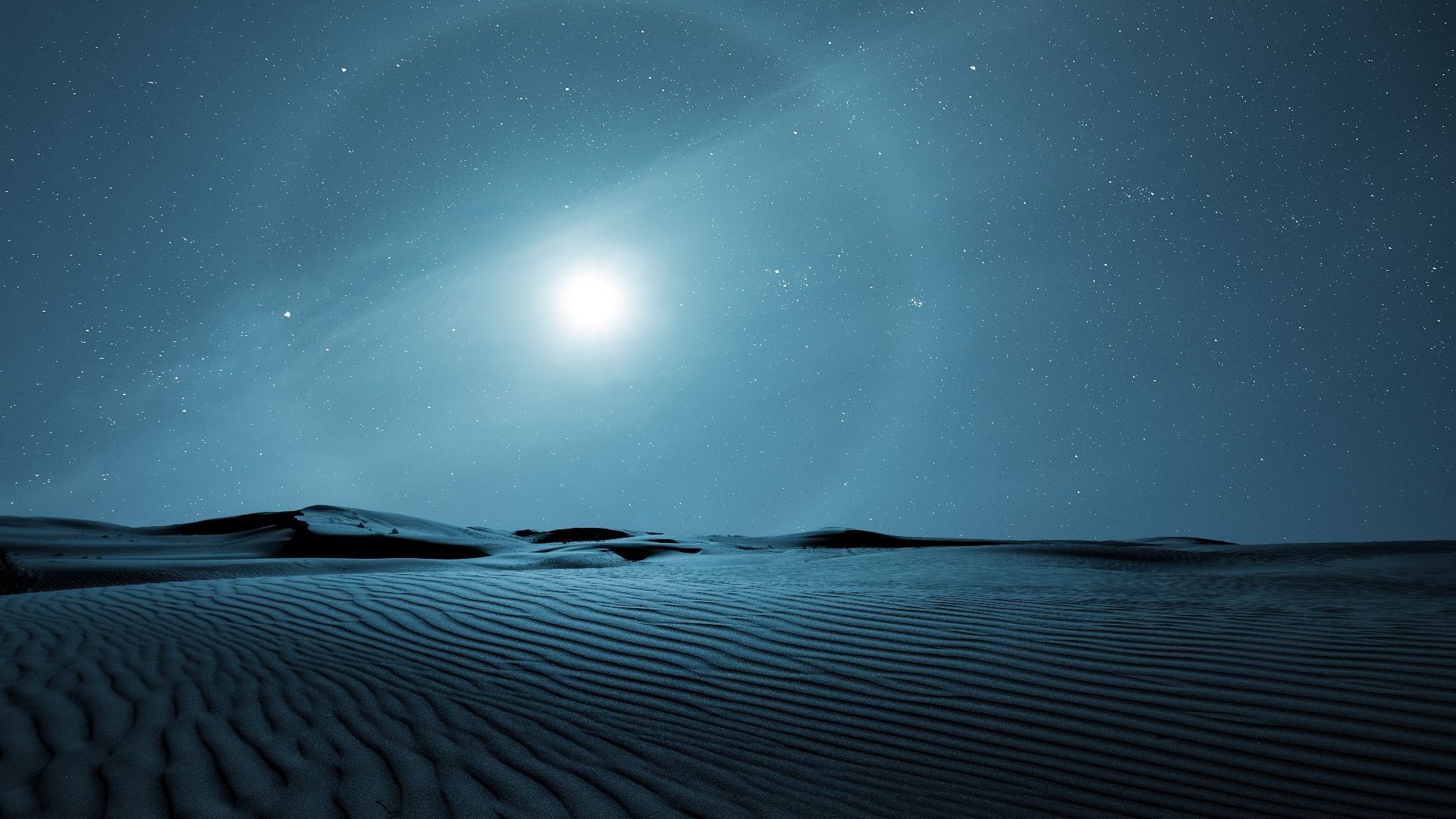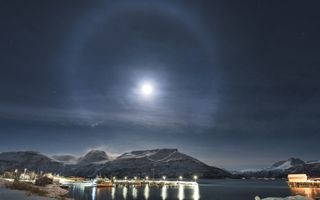Why Is There A Halo Around The Moon? This mesmerizing celestial phenomenon, a luminous ring encircling the moon, sparks curiosity and wonder. At WHY.EDU.VN, we delve into the science behind lunar halos, offering clear explanations and fascinating insights. Discover the atmospheric optics and ice crystal refraction that create this captivating display, plus explore related weather phenomena.
Table of Contents
- 1. What is a Moon Halo and How Does it Form?
- 2. The Science Behind the 22-Degree Halo
- 3. Unpacking the Prism Effect in Lunar Halos
- 4. Do Lunar Halos Have Company? Exploring Related Optical Phenomena
- 5. Solar Halos vs. Lunar Halos: What’s the Difference?
- 6. Rare Lunar Halo Displays: Double, Triple, and Quadruple Halos
- 7. Decoding “Holes in the Sky”: Darkened Regions Inside Halos
- 8. How Common Are Moon Halos: When and Where to See Them
- 9. Best Conditions for Viewing Lunar Halos
- 10. Myths and Cultural Significance of Moon Halos
- 11. Lunar Halos as Weather Predictors: Fact or Fiction?
- 12. Folklore and Proverbs Surrounding Lunar Halos
- 13. Beyond Lunar Halos: Other Atmospheric Optical Phenomena
- 14. Gravitational Lensing: When Distant Galaxies Bend Light
- 15. Understanding Halos: A Comprehensive FAQ
1. What is a Moon Halo and How Does it Form?
A moon halo, also known as a lunar halo or a 22-degree halo, is a luminous ring that appears around the moon. This optical phenomenon arises from the refraction and reflection of moonlight by millions of tiny ice crystals suspended high in the Earth’s atmosphere. These ice crystals, typically found in cirrus or cirrostratus clouds, act like miniature prisms, bending and scattering the moonlight to create a halo effect. The halo appears as a large, diffuse ring with the moon at its center. Understanding moon rings requires knowledge of atmospheric optics and weather conditions.
2. The Science Behind the 22-Degree Halo
The most common type of moon halo is the 22-degree halo. The “22-degree” refers to the angular radius of the halo, meaning that the ring appears to be approximately 22 degrees away from the moon. This specific angle is determined by the hexagonal shape of the ice crystals and their refractive properties. Light entering the ice crystals is bent at a minimum angle of approximately 22 degrees, causing the halo to form at this specific radius. According to Atmospheric Optics, the uniformity in diameter arises because ice has a specific index of reflection and the hexagonal shape of an ice crystal means when its sides are extended it forms a prism with a 60-degree apex angle. This results in an angle of minimum deviation for light passing through the ice crystal of 21.84 degrees.
3. Unpacking the Prism Effect in Lunar Halos
Ice crystals act as prisms, separating white light from the moon into its component colors. This is similar to how raindrops create a rainbow. However, in moon halos, the colors are usually much fainter and harder to see with the naked eye. The red light is bent the least, appearing on the inner edge of the halo, while the blue light is bent the most, appearing on the outer edge. The Hyperphysics site explains that the colors in the lunar halo are often too weak to be seen with the naked eye and may be much more visible around the sun because of how much brighter it is than the moon.
4. Do Lunar Halos Have Company? Exploring Related Optical Phenomena
Lunar halos can sometimes be accompanied by other optical phenomena, such as coronas and sun dogs.
- Coronas: These are smaller, colorful rings that appear closer to the moon and are caused by the diffraction of light by water droplets.
- Sun dogs: These are bright spots of light that appear on either side of the sun and are caused by the refraction of sunlight by ice crystals.
In addition to these, double halos can also occur.
| Phenomenon | Cause | Appearance | Relation to Lunar Halos |
|---|---|---|---|
| Coronas | Diffraction by water droplets | Smaller, colorful rings near the moon | Often accompany halos |
| Sun dogs | Refraction by ice crystals | Bright spots beside the sun | Similar ice crystal effect |
| Double Halos | Refraction by ice crystals | Two concentric halos | Rare, ice crystal refraction |


5. Solar Halos vs. Lunar Halos: What’s the Difference?
Solar halos and lunar halos are both caused by the refraction of light by ice crystals in the atmosphere. The main difference is that solar halos are caused by sunlight, while lunar halos are caused by moonlight. Because the sun is much brighter than the moon, solar halos are usually much brighter and more colorful than lunar halos. However, the basic physics behind both phenomena is the same.
6. Rare Lunar Halo Displays: Double, Triple, and Quadruple Halos
While 22-degree halos are the most common, rarer displays such as double, triple, and even quadruple lunar halos can occur under specific atmospheric conditions. These displays involve multiple concentric rings of light surrounding the moon. A quadruple lunar halo, observed in Madrid, Spain, in 2012, involved a combination of 22-degree halo, a circumscribed halo, a 46-degree halo, and a 46-degree circular halo.
| Type of Halo | Frequency | Description | Formation Conditions |
|---|---|---|---|
| Single (22°) | Common | Single ring of light at 22 degrees from the moon | Standard cirrus cloud conditions |
| Double | Rare | Two concentric rings | Specific ice crystal alignment |
| Triple | Very Rare | Three concentric rings | Complex atmospheric layering |
| Quadruple | Extremely Rare | Four concentric rings, involving different halo types | Unique combination of ice crystal types |
7. Decoding “Holes in the Sky”: Darkened Regions Inside Halos
The area inside a 22-degree halo often appears darker than the surrounding sky. This effect, sometimes referred to as a “hole in the sky,” occurs because the ice crystals direct light away from the center of the halo. The optical properties of the ice crystals mean that they don’t direct light back toward the center of a halo. This means that the sky inside a 22-degree halo can often appear darker than the surrounding sky making it appear like a “hole in the sky.”
8. How Common Are Moon Halos: When and Where to See Them
Moon halos are relatively common, especially during winter months. Farmers’ Almanac describes lunar halos as being fairly common, meaning there is a good chance of spotting one, as long as you are willing to brave cold and possibly wet weather. That’s because though lunar halos can happen at any time of year, they are more common in winter. They are more likely to be visible when a full or nearly full moon is present and when the sky is covered with thin cirrus or cirrostratus clouds.
9. Best Conditions for Viewing Lunar Halos
To maximize your chances of seeing a moon halo, look for the following conditions:
- Full or Nearly Full Moon: A brighter moon provides more light to be refracted by ice crystals.
- Cirrus or Cirrostratus Clouds: These thin, high-altitude clouds contain the ice crystals necessary for halo formation.
- Clear, Dark Sky: Away from city lights, the halo will be more visible.
- Winter Months: Ice crystals are more prevalent in the atmosphere during colder months.
10. Myths and Cultural Significance of Moon Halos
Throughout history, moon halos have been associated with various myths and cultural beliefs. In many cultures, a halo around the moon is considered a sign of impending bad weather. This is because cirrus clouds, which cause halos, often precede the arrival of a warm front and a low-pressure system. In folklore, the observation of a lunar halo has been associated with forthcoming unsettled weather, especially during winter.
11. Lunar Halos as Weather Predictors: Fact or Fiction?
While it’s true that cirrus clouds can indicate an approaching warm front, it’s not always the case. Therefore, lunar halos are not always reliable predictors of bad weather. Because cirrus clouds often signal rain falling within the next 24 hours the atmospheric optical illusions they cause became embedded in “weather lore” becoming an early method of empirically predicting the weather before the development of metrology.
12. Folklore and Proverbs Surrounding Lunar Halos
Many proverbs and sayings relate to moon halos and their supposed ability to predict the weather.
One example, as mentioned in the book Dictionary of Proverbs by George Latimer Apperson:
“If the moon show a silver shield,
Be not afraid to reap your field;
But if she rises haloed round,
Soon we’ll tread on deluged ground.”
These sayings reflect the historical importance of observing natural phenomena to predict weather patterns.
13. Beyond Lunar Halos: Other Atmospheric Optical Phenomena
The atmosphere is responsible for a variety of other stunning optical phenomena, including:
- Rainbows: Formed by the refraction and reflection of sunlight by raindrops.
- Mirages: Caused by the bending of light rays in areas of extreme temperature gradients.
- Auroras: Displays of light in the sky caused by the interaction of charged particles from the sun with the Earth’s atmosphere.
14. Gravitational Lensing: When Distant Galaxies Bend Light
While atmospheric phenomena like lunar halos involve relatively small-scale bending of light, the universe offers examples of light bending on a much grander scale. Gravitational lensing, as the European Space Agency (ESA) explains, occurs when the gravity of massive objects, like galaxies or black holes, bends and magnifies the light from more distant objects behind them.
15. Understanding Halos: A Comprehensive FAQ
1. What causes a moon halo?
Moon halos are caused by the refraction and reflection of moonlight by ice crystals in the atmosphere.
2. Are moon halos a sign of bad weather?
They can indicate approaching weather changes, but they are not always reliable predictors.
3. How common are moon halos?
Moon halos are relatively common, especially in winter.
4. What is a 22-degree halo?
This refers to the angular radius of the most common type of moon halo.
5. Can you see colors in a moon halo?
Yes, but they are usually faint and hard to see with the naked eye.
6. What are coronas?
Smaller, colorful rings that appear closer to the moon and are caused by water droplets.
7. What are sun dogs?
Bright spots of light that appear on either side of the sun and are caused by ice crystals.
8. What is gravitational lensing?
The bending of light by massive objects in space.
9. Why does the sky inside a halo appear darker?
The ice crystals direct light away from the center of the halo.
10. What kind of clouds cause moon halos?
Cirrus or cirrostratus clouds.
Do you have more questions about moon halos or other celestial phenomena? At WHY.EDU.VN, we’re dedicated to providing clear, accurate, and engaging answers to your questions. Visit our website at why.edu.vn, or contact us at 101 Curiosity Lane, Answer Town, CA 90210, United States, or via Whatsapp at +1 (213) 555-0101. Our team of experts is ready to help you explore the wonders of the universe.

